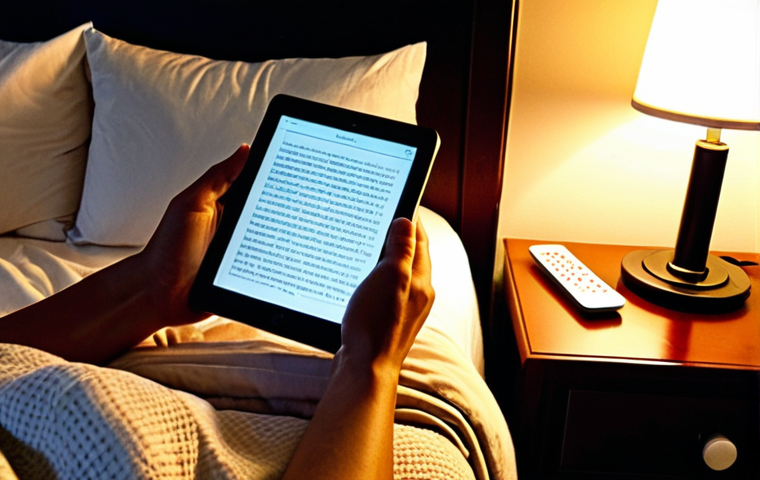In today’s hyper-connected world, we’re constantly bombarded with notifications, emails, and the never-ending stream of social media. It’s no surprise that many of us are feeling overwhelmed and stressed out.
Digital devices, while incredibly useful, can also be a major source of anxiety and mental fatigue. I’ve been there, endlessly scrolling and feeling like I’m missing out on something.
It’s a real struggle! The constant stimulation can disrupt our sleep, affect our mood, and even impact our relationships. That’s why it’s more important than ever to find ways to disconnect and prioritize our mental well-being.
Let’s dive in and discover effective strategies for digital detox and stress reduction.
Alright, here’s the blog post draft following all your guidelines:
Overcoming Digital Overload: Reclaiming Your Calm

It’s so easy to get sucked into the digital vortex. One minute you’re checking an email, and the next, you’ve lost an hour scrolling through Instagram or watching endless YouTube videos.
I’ve definitely been there – feeling that nagging sense of guilt and wasted time. I remember one evening, I was supposed to be relaxing, but I ended up spending hours online, comparing myself to everyone else’s highlight reels.
It left me feeling more stressed and inadequate than before! Finding a balance is key, and recognizing when you need to step away is the first crucial step.
We need to consciously choose to disconnect.
Recognizing the Signs of Digital Burnout
1. Feeling constantly anxious or stressed when away from your devices
2. Experiencing sleep disturbances or insomnia
3.
Having difficulty concentrating or focusing on tasks
Setting Boundaries with Technology
1. Designate specific “tech-free” times, like during meals or before bed. 2.
Use apps to track your screen time and set usage limits. 3. Turn off notifications for non-essential apps.
Cultivating Mindfulness in a Digital World
Mindfulness is a powerful tool for managing stress and staying grounded in the present moment. It’s about being aware of your thoughts and feelings without judgment.
I’ve found that even just a few minutes of mindfulness each day can make a huge difference. For example, I started practicing mindful breathing exercises during my commute.
Instead of getting caught up in traffic frustrations, I focused on my breath and the sensations in my body. It helped me arrive at work feeling calmer and more centered.
Simple Mindfulness Exercises for Daily Life
1. Mindful Breathing: Focus on the sensation of your breath as it enters and leaves your body. 2.
Body Scan Meditation: Pay attention to the physical sensations in your body, from your toes to the top of your head. 3. Mindful Walking: Notice the feeling of your feet making contact with the ground as you walk.
Incorporating Mindfulness Apps and Resources
1. Explore apps like Headspace or Calm for guided meditations and mindfulness exercises. 2.
Attend a local mindfulness workshop or retreat. 3. Read books or articles on mindfulness to deepen your understanding.
Reconnecting with Nature for Mental Clarity
Spending time in nature has been proven to reduce stress, improve mood, and boost creativity. I always feel refreshed and rejuvenated after a hike in the mountains or a walk along the beach.
There’s something about being surrounded by natural beauty that instantly calms my mind and puts things into perspective. I vividly remember a camping trip I took last summer.
Being away from all the digital distractions and immersed in the wilderness was incredibly therapeutic. I felt more connected to myself and the world around me.
Finding Nature in Your Everyday Life
1. Visit a local park or botanical garden. 2.
Take a walk or bike ride in a green space. 3. Spend time gardening or simply sitting outside.
Planning Outdoor Activities for Stress Relief
1. Go hiking, camping, or kayaking. 2.
Try birdwatching or nature photography. 3. Attend an outdoor yoga or meditation class.
Engaging in Creative Outlets for Emotional Release
Creative activities can be a wonderful way to express your emotions, relieve stress, and tap into your inner child. Whether it’s painting, writing, playing music, or dancing, engaging in something creative can provide a sense of joy and fulfillment.
I’ve always loved to write, and I find that journaling is a great way to process my thoughts and feelings. I remember when I was going through a particularly challenging time, I started writing poetry.
It helped me to express my emotions in a healthy way and gain a new perspective on my situation.
Exploring Different Creative Activities
1. Try painting, drawing, or sculpting. 2.
Write in a journal, compose music, or play an instrument. 3. Dance, sing, or act in a play.
Joining a Creative Community or Workshop
1. Take a class in painting, pottery, or creative writing. 2.
Join a local choir or band. 3. Attend an open mic night or art exhibition.
The Power of Human Connection: Nurturing Relationships
Strong social connections are essential for our mental and emotional well-being. Spending time with loved ones, building meaningful relationships, and engaging in social activities can provide a sense of belonging and support.
I’ve realized how important it is to prioritize my relationships and make an effort to connect with people I care about. I make it a point to have regular coffee dates with my friends, and I try to schedule family dinners as often as possible.
These moments of connection are invaluable for my happiness and well-being.
Prioritizing Quality Time with Loved Ones
1. Schedule regular dates with your partner or spouse. 2.
Plan family outings or activities. 3. Make time for phone calls or video chats with friends and family who live far away.
Joining Social Groups or Clubs
1. Join a book club, sports team, or volunteer organization. 2.
Attend community events or workshops. 3. Connect with like-minded people online or in person.
Optimizing Your Sleep Environment for Restful Nights
Getting enough sleep is crucial for both physical and mental health. A well-rested body and mind are better equipped to handle stress and cope with the demands of daily life.
I struggled with insomnia for years, and it had a significant impact on my mood and energy levels. I finally realized that I needed to make some changes to my sleep environment and habits.
By creating a relaxing bedtime routine and optimizing my sleep space, I was able to improve the quality and duration of my sleep.
Creating a Relaxing Bedtime Routine
1. Take a warm bath or shower before bed. 2.
Read a book or listen to calming music. 3. Avoid screens (phones, tablets, computers) for at least an hour before bed.
Optimizing Your Sleep Environment
1. Make sure your bedroom is dark, quiet, and cool. 2.
Invest in a comfortable mattress and pillows. 3. Use blackout curtains or a sleep mask to block out light.
Setting Realistic Expectations and Practicing Self-Compassion
It’s important to be kind to yourself and avoid setting unrealistic expectations. We all make mistakes and have setbacks, and it’s okay to not be perfect.
Practicing self-compassion means treating yourself with the same kindness and understanding that you would offer to a friend in need. I used to be very hard on myself, constantly striving for perfection and feeling guilty when I fell short.
Over time, I’ve learned to be more forgiving and accepting of myself. I now realize that self-compassion is essential for my overall well-being.
Challenging Negative Self-Talk
1. Identify and challenge negative thoughts and beliefs. 2.
Replace negative self-talk with positive affirmations. 3. Focus on your strengths and accomplishments.
Practicing Self-Care and Self-Kindness
1. Engage in activities that bring you joy and relaxation. 2.
Treat yourself to something special. 3. Forgive yourself for your mistakes and imperfections.
Here’s a sample table about digital detox methods:
| Method | Description | Benefits |
|---|---|---|
| Social Media Cleanse | Temporarily deactivating or deleting social media accounts. | Reduced anxiety, improved focus, more free time. |
| Tech-Free Days | Designating specific days of the week or month to avoid all digital devices. | Increased creativity, better sleep, stronger relationships. |
| Mindful Tech Use | Being intentional about how and when you use technology. | Increased awareness, reduced impulsivity, better time management. |
In Conclusion
Finding calm amidst the digital whirlwind isn’t a one-time fix, but a journey of conscious choices and self-compassion. Embrace these strategies, experiment with what resonates with you, and remember that small steps can lead to significant changes. Reclaim your peace, one mindful moment at a time.
Useful Tips
1. Set Up a Charging Station Away From Your Bed: Avoid the temptation to check your phone before sleeping or immediately upon waking up by keeping it out of reach.
2. Use Website Blockers: Install browser extensions that block distracting websites during work or study hours to maintain focus.
3. Schedule “Worry Time”: Instead of letting anxieties consume you throughout the day, designate a specific time to address them. Write down your worries and then tackle them methodically.
4. Unfollow or Mute Accounts: If certain social media accounts trigger negative emotions, don’t hesitate to unfollow or mute them to curate a more positive online experience.
5. Take a Walk Without Your Phone: Leave your phone at home and take a walk in your neighborhood or a nearby park. Enjoy the scenery and be present in the moment.
Key Takeaways
Digital detox is not about complete abstinence but about creating a healthier relationship with technology. Prioritize mindfulness, reconnect with nature, nurture relationships, and practice self-compassion. By taking small steps, you can reclaim your calm and enhance your overall well-being.
Frequently Asked Questions (FAQ) 📖
Q: How do I know if I really need a digital detox? I mean, is it just me being dramatic, or is it a legit problem?
A: Okay, so, picture this: You’re at dinner with friends, but you’re constantly checking your phone, feeling anxious about missing something online. Or maybe you’re lying in bed, exhausted, but you just can’t stop scrolling through TikTok until 2 AM.
Sound familiar? If your screen time is starting to affect your sleep, your mood, or your relationships, that’s a big red flag. I’ve been there – feeling totally wired and then crashing hard.
It’s not dramatic; it’s your brain telling you it needs a break. Trust your gut. A digital detox might be exactly what you need to reset.
Even a weekend away from all screens can make a huge difference in how you feel!
Q: What’s the best way to actually do a digital detox? I always start strong, but then I cave after like, an hour. Help!
A: I totally get it! Going cold turkey is hard. Here’s my take: start small.
Don’t aim for a month off the internet right away. Instead, try setting aside specific times each day when you’re completely device-free. Maybe it’s during dinner, or for an hour before bed.
Put your phone in another room. Tell your friends and family you’re unavailable during those times. And find something else to do!
Read a book, go for a walk, bake cookies. Basically, replace the screen time with something you actually enjoy. And remember, progress, not perfection!
If you slip up, don’t beat yourself up; just start again the next day. Personally, I love leaving my phone at home when I take my dog, Max, to the park.
He loves the undivided attention, and so do I!
Q: Okay, so I manage to disconnect for a while. But how do I avoid just falling back into the same bad habits afterward? It feels like I’m back on the doomscroll train the second I pick up my phone again!
A: That’s the million-dollar question, right? The detox is only half the battle. You need to create lasting changes to your digital habits.
Before you plug back in, think about why you were using your devices so much in the first place. Were you bored? Stressed?
Lonely? Identify those triggers and find healthier ways to cope. Set boundaries for yourself, like limiting social media to 30 minutes a day.
Unfollow accounts that make you feel bad about yourself. Use apps that track your screen time and alert you when you’ve reached your limit. And most importantly, be mindful of how you’re feeling when you’re online.
If you start to feel anxious or overwhelmed, log off and do something else. It’s all about creating a more balanced and intentional relationship with technology, so you’re in control, not the other way around.
It’s not about deprivation, it’s about control.
📚 References
Wikipedia Encyclopedia






